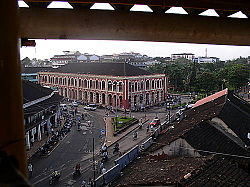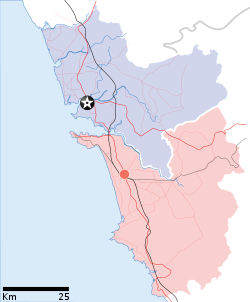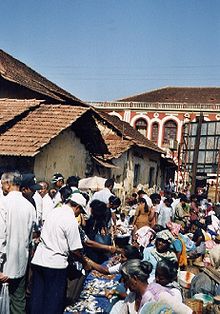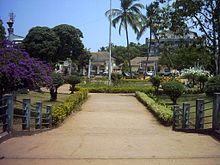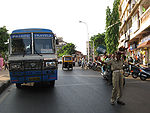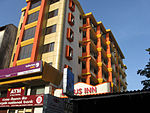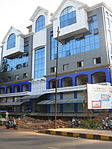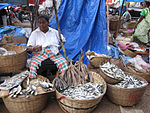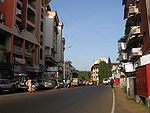- Margao
-
See also: Salcette
मडगांव/Moddganv
Margao
— city — Margao City Square. Coordinates 15°18′N 73°57′E / 15.30°N 73.95°ECoordinates: 15°18′N 73°57′E / 15.30°N 73.95°E Country India State Goa District(s) South Goa Mayor Mr.Azgaokar Population 78,393 (2001[update]) Time zone IST (UTC+05:30) Area
• 10 metres (33 ft)
Margao (Konkani: मडगांव Moddganv, pronounced [mɔɽɡãːw] (
 listen) is the second largest city (population approximately 80,000) and commercial capital of the Indian state of Goa. It is the administrative headquarters of South Goa district and of the Salcete taluka.
listen) is the second largest city (population approximately 80,000) and commercial capital of the Indian state of Goa. It is the administrative headquarters of South Goa district and of the Salcete taluka.Contents
Etymology
Margão is the Portuguese spelling, with Margao being common in English. It is derived from Mathagrām which means a place with a matha. Pronounced as "Mut" as sound in word "Hut". Mut is a religious place where religious society called "Mathgram" looks after it.
Geography
Margao is located at 15°18′N 73°57′E / 15.30°N 73.95°E.[1] It has an average elevation of 31 metres (102 feet).
Nestled on the banks of the River Sal, Margão is amongst the oldest recorded towns in Goa.[citation needed] Margão is famous for the huge Portuguese style mansions which dot its landscape. It is also one of the fastest growing cities in Goa and includes several suburbs including Aquem, Fatorda, Gogol, Borda, Comba and Davorlim.
History
Margao in pre-Portuguese times was one of the important settlements in Salcete and known as Matha Grama (the village of Mathas) as it was a temple town with nine Mathas in temple schools. Most of the inhabitants were Brahmins (GSB and Daivajnas). It was then famous for its many beautifully built temples. Long before the Portuguese came here, it had a university with a library.[citation needed] During the Portuguese conquest in 1543, Hindu temples were demolished and Catholic churches were built in their place.[citation needed] Almost all traces of Hindu settlements were wiped out.[citation needed] The first church to be built in Margão, and its replacement in 1579, were destroyed by raiders along with the seminary that had been built alongside.[citation needed] The present church was built in 1675.[2][3]
The initial settlement of Margao grew from the site of the ancient Damodar Temple. The original temple was demolished and the temple tank was filled up to be replaced by the Holy Spirit church and church grounds[citation needed]. The Hindus carried their deity Damodar (a form of Lord Shiva) across the Zuari Agranashini river to the Hindu territories held by the Sonde rulers.[citation needed] While the western side of the Church developed as a market place, the settlement grew on the eastern side, that is, the Borda region, with the church at its core and extended outwards.
The Holy Spirit main square is defined on one side by the church with its baroque architecture and the parochial house, and on the other side by the palatial mansions of affluent elite Catholics, positioned in a row. The Associação das Communidades building and the school being the odd exceptions. They add to its character and sense of scale. They have a maximum height of two stories, and balcões and varandas facing the square. Parallel to the church square is the commercial street (old market). There is also a landscaped area next to the church called Praça da Alegria (joy square).
Margao's importance as an administrative and commercial area grew with the increasing dependence of the surrounding towns and villages; leading to the administrative centre with the town hall at its centre being built in the south. The commercial market became attached to it and was hence called maud-gao or the market town of Goa, and since then the city has grown towards the east.
In 1961, Goa was incorporated into the Indian Union, and Margao was declared as the administrative centre of the district of South Goa.
Demographics
As of 2011[update] India census,[4] Margao had a population of 78,393. Males constitute 51% of the population and females 49%. Margao has an average literacy rate of 87.4%, higher than the national average of 74%: male literacy is 91%, and female literacy is 83%. In Margao, 11% of the population is under 6 years of age.[citation needed]
Education
Margao hosts many prestigious schools and colleges. Among the schools known for excellence is the Mahila and Nutan English high school The Model English High School, popularly known after its founder Shri. Bhatikar, was established in the year 1935 and is one of the leading educational institutions in the state of Goa as per the curriculum prescribed by the Directorate of Education, Goa, and the Goa Board of Secondary and Higher Secondary Education, Goa. Manovikas High School now located in Sonsodo is one of the premier ICSE school in Goa.[citation needed] The other educational institutes in Margao include St. Joseph High School at Aquem, Presentation Convent (for girls), Fatima Convent (for girls) near Old Bus Stand.
Margao is also the location of three of the best[citation needed] colleges in Goa - Smt. Parvatibai Chowgule Cultural Foundations College of Arts and Science, Shri Damodar College of Commerce and Economics and Shree Damodar Higher Secondary School Of Science. There are also ITIs (Industrial Training Institutes) which impart technical education.
Transport
 Skybus Metro at a station
Skybus Metro at a station
The Margao Railway station is Goa's biggest and most important[citation needed] as it is a railway junction positioned at the intersection of the Konkan Railway and the South Western Railway. Almost all trains passing through Goa stop here, and it is the gateway to south Goa. Hence Margao is used more commonly as a transit stop rather than as a tourist destination, by many people who either head off down south to Palolem (38 km) or to Benaulim and Colva which are about six kilometers away. Margao is connected by road to other cities like Mangalore, Udupi, Karwar, Ratnagiri, and Mumbai through national highway 17(NH-17). Also there is road which connects Margao to Ponda and other towns of Goa state.
The city hosts the test track for Skybus Metro,[5] an elevated rail system which is patented by the Konkan Railway Corporation.[6] The Skybus Metro project was later scrapped due to an accident which occurred during the test drive killing one engineer and a seriously injuring a crew of three.[7] However, Mr B Rajaram who had invented the rail system has stated that in his opinion, the accident was avoidable.[8]
Language
Konkani is the most widely spoken language in Margao. Marathi is the other significant language. Portuguese is also spoken and understood by a small number of people. English & Hindi are understood by a majority of the population. Konkani in South Goa is different from that spoken in North Goa. Konkani from Margao is considered to be standard Konkani.
Tourism
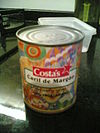 Can of curry from Margão, in Portugal.
Can of curry from Margão, in Portugal.
The city has many sights and destinations. These include the 'Closed' Market called, in the Portuguese language, Mercado de Afonso de Albuquerque or in Konkani as "Pimplapedd" or "Pimpalakatta," the municipal building (Câmara), the municipal garden, Anna Fonte (natural springs), Old Market or Mercado Velho, Holy Spirit Church, grand colonial mansions (especially the Seven Gables House near the church), the chapel at Monte Hill, the Hindu crematorium or 'Smashan' and the Muslim burial ground or 'Kabrasthan' both situated on Pajifond's Rua das Saudades.
Some of the city suburbs include Pajifond, Aquem, Gogol, Borda, Malbhat, Kharebandh, Old Market, Navelim and Comba, the last two being the oldest parts of the city.
There are a number of churches and temples in Margao, since the population is predominantly Roman Catholic or Hindu with a Muslim minority. The famous churches in Margao are the Holy Spirit Church, the Grace Church, The St Sebastian Church in Aquem (The Old St. Sebastian Chapel, popularly known as the Pandava Copel still stands proud next to the modern St. Sebastian Church) and the Monte Hill Chapel, the famous temples are the 'Damodar Temple' (Saal)which is revered by Margao's Hindus and Christians, the 'Hari Mandir', the 'Maruti Mandir' at Davorlim the 'Saibaba Temple' at Davorlim, the 'Shiv Temple' (Ling) at Fatorda near Nehru Stadium (which is the original Temple of Damudora). There are 2 mosques in Margao, One in the Malbhat area and one on the Monte hill catering to the Muslim population in these areas. Presently, since 2004, there are twenty-four new mosques in Margao. There is also a Jain temple at Pajifond.
Landmarks
Some lesser known information about some famous landmarks:
Margao city hall: The city hall is situated in the heart of the city.
Margao municipal garden: The northern segment of the Margao municipal garden was developed by the Mavany family and is named after Aga Khan, during his visit just before Goa's liberation. The entire garden is now Municipal property and is maintained by the Margao Municipal Council.
Narcinva D. Naik residence/Damodar Sal:Swami Vivekananda stayed in this house during his visit to Goa in October 1892.[9] The mansion also houses Margao's well-known temple-hall "Dambaba Saal".
Culture
The town is also known as the cultural capital of Goa. A culture center named 'Ravindra Bhavan' was inaugurated by the Chief Minister of Goa, Digambar Kamat in July 2008 at Fatorda. It also has Goa's biggest sports stadium, the Nehru Stadium at Fatorda.[10]
Some of the theaters in Margao include the Gomant Vidya Niketan, OSIA Multiplex, Vishant and Lata; in addition to Goa's biggest theater, the Metropole.
The Dindi festival at the Vithal Rakhumai temple in the Comba ward occurs on the 2nd day after Diwali. A procession of the deity takes place at night through the city. A large congregation of Goans, Hindhus, Christians, Muslims, whether from Margao or from the surrounding areas, in the festive attire can be seen at the huge open air market outside the temple and across the main city. The feast of the Holy Spirit Church, locally known as purumetache fest occurs just before the Monsoon sets in. People from all over Goa congregate at the special market to buy spices and dried fish to be used during the oncoming rainy season.
The usual specialities that are found in the cuisine of Goa are also to be found in Margao. The curry of Margao is a praised local speciality. Cans of curry of Margao are currently exported to Portugal and elsewhere.
Margão is also the name of a brand of spices sold in Portugal.
Gallery
- Life in Margao
See also
Madgaon (MAO) Next 'Small' station towards Mumbai:
MajordaKonkan Railway : Railway (India) Next 'Small' station from Mangalore:
BalliDistance from Mumbai(CST) = 0765 KM Next 'Main' station towards Mumbai:
KudalKonkan Railway : Railway (India) Next 'Main' station from Mangalore
KarwarReferences
- ^ Falling Rain Genomics, Inc - Margao
- ^ "Hindu temples and deities" by Rui Gomes Pereira
- ^ "Gomantak Prakruti ani Sanskruti" by B.D.Satoskar
- ^ "Census of India 2001: Data from the 2001 Census, including cities, villages and towns (Provisional)". Census Commission of India. Archived from the original on 2004-06-16. http://web.archive.org/web/20040616075334/http://www.censusindia.net/results/town.php?stad=A&state5=999. Retrieved 2008-11-01.
- ^ Skybus page from konkanrailway.com
- ^ Patent of Skybus from konkanrailway.com
- ^ Accident details
- ^ https://docs.google.com/document/pub?id=1yYQcyramb5wecESziWdwWZtxdXkZpUQ897COcdE8H1I
- ^ News article from goacom.com
- ^ Cricinfo page on Nehru Stadium
External links
Categories:- Cities and towns in South Goa district
- Railway stations on Konkan Railway
- South Goa district
Wikimedia Foundation. 2010.

